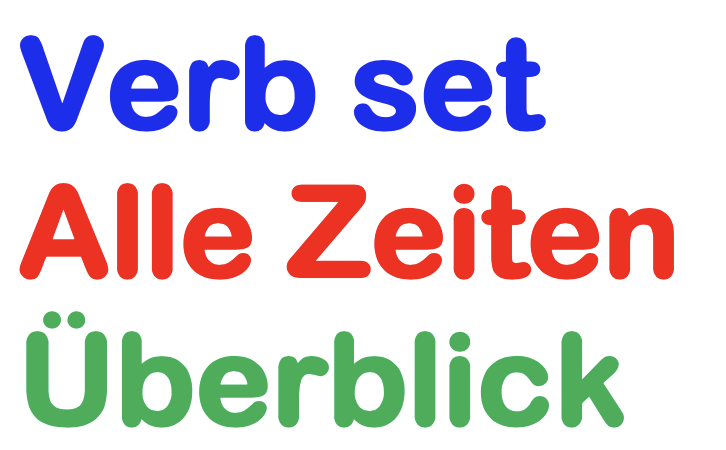Verb set alle Zeiten und Personalformen:
Bilde vom Verb “set” (festlegen, setzen, einstellen) alle Personen in allen Zeiten in Englisch.
Die drei unregelmäßigen Stammformen lauten: set – set – set

Present Simple:
1.P.EZ.: I set
2.P.EZ.: you set
3.P.EZ.: he/she/it sets
1.P.MZ.: we set
2.P.MZ.: you set
3.P.MZ.: they set
Present Progressive
1.P.EZ.: I am setting
2.P.EZ.: you are setting
3.P.EZ.: he/she/it is setting
1.P.MZ.: we are setting
2.P.MZ.: you are setting
3.P.MZ.: they are setting
Past Simple:
1.P.EZ.: I set
2.P.EZ.: you set
3.P.EZ.: he/she/it set
1.P.MZ.: we set
2.P.MZ.: you set
3.P.MZ.: they set
Past Progressive
1.P.EZ.: I was setting
2.P.EZ.: you were setting
3.P.EZ.: he/she/it was setting
1.P.MZ.: we were setting
2.P.MZ.: you were setting
3.P.MZ.: they were setting
Present Perfect Simple
1.P.EZ.: I have set
2.P.EZ.: you have set
3.P.EZ.: he/she/it has set
1.P.MZ.: we have set
2.P.MZ.: you have set
3.P.MZ.: they have set
Present Perfect Progressive
1.P.EZ.: I have been setting
2.P.EZ.: you have been setting
3.P.EZ.: he/she/it has been setting
1.P.MZ.: we have been setting
2.P.MZ.: you have been setting
3.P.MZ.: they have been setting
Past Perfect Simple
1.P.EZ.: I had set
2.P.EZ.: you had set
3.P.EZ.: he/she/it had set
1.P.MZ.: we had set
2.P.MZ.: you had set
3.P.MZ.: they had set
Past Perfect Progressive
1.P.EZ.: I had been setting
2.P.EZ.: you had been setting
3.P.EZ.: he/she/it had been setting
1.P.MZ.: we had been setting
2.P.MZ.: you had been setting
3.P.MZ.: they had been setting
will-Future:
1.P.EZ.: I will set
2.P.EZ.: you will set
3.P.EZ.: he/she/it will set
1.P.MZ.: we will set
2.P.MZ.: you will set
3.P.MZ.: they will set
will-Future Progressive
1.P.EZ.: I will be setting
2.P.EZ.: you will be setting
3.P.EZ.: he/she/it will be setting
1.P.MZ.: we will be setting
2.P.MZ.: you will be setting
3.P.MZ.: they will be setting
going-to-Future Simple:
1.P.EZ.: I am going to set
2.P.EZ.: you are going to set
3.P.EZ.: he/she/it is going to set
1.P.MZ.: we are going to set
2.P.MZ.: you are going to set
3.P.MZ.: they are going to set
going-to-Future Progressive:
1.P.EZ.: I am going to be setting
2.P.EZ.: you are going to be setting
3.P.EZ.: he/she/it is going to be setting
1.P.MZ.: we are going to to be setting
2.P.MZ.: you are going to be setting
3.P.MZ.: they are going to be setting
Future Perfect:
1.P.EZ.: I will have set
2.P.EZ.: you will have set
3.P.EZ.: he/she/it will have set
1.P.MZ.: we will have set
2.P.MZ.: you will have set
3.P.MZ.: they will have set
Future Perfect Progressive:
1.P.EZ.: I will have been setting
2.P.EZ.: you will have been setting
3.P.EZ.: he/she/it will have been setting
1.P.MZ.: we will have been setting
2.P.MZ.: you will have been setting
3.P.MZ.: they will have been setting
Conditional Present:
1.P.EZ.: I would set
2.P.EZ.: you would set
3.P.EZ.: he/she/it would set
1.P.MZ. we would set
2.P.MZ. you would set
3.P.MZ. they would set
Conditional Present Progressive:
1.P.EZ.: I would be setting
2.P.EZ.: you would be setting
3.P.EZ.: he/she/it would be setting
1.P.MZ. we would be setting
2.P.MZ. you would be setting
3.P.MZ. they would be setting
Conditional Perfect:
1.P.EZ.: I would have set
2.P.EZ.: you would have set
3.P.EZ.: he/she/it would have set
1.P.MZ. we would have set
2.P.MZ. you would have set
3.P.MZ. they would have set
Conditional Perfect Progressive:
1.P.EZ.: I would have been setting
2.P.EZ.: you would have been setting
3.P.EZ.: he/she/it would have been setting
1.P.MZ. we would have been setting
2.P.MZ. you would have been setting
3.P.MZ. they would have been setting
